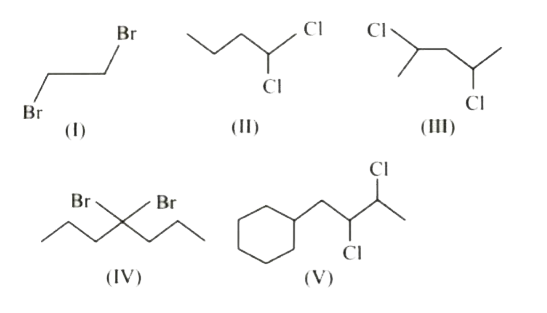Vicinal dihalide is
CH3CH2Br
BrCH2CH2Br
CH3CHBr2
CH2=CHBr
The correct Answer is:B
Step-by-Step Solution:
1. Understanding the Terms:
- The term "di" in chemistry refers to the presence of two identical or different groups attached to a molecule.
- "Halide" refers to a halogen atom (fluorine, chlorine, bromine, iodine) that is bonded to a carbon atom in an organic compound.
2. Defining Vicinal:
- The term "vicinal" refers to the relative positions of substituents on a carbon chain. Specifically, vicinal dihalides have two halogen atoms attached to adjacent carbon atoms in a chain.
3. Identifying Vicinal Dihalides:
- A vicinal dihalide can be represented as R-CH(X)-CH(Y)-R', where X and Y are halogen atoms (e.g., Cl, Br, I) and R and R' can be hydrogen or alkyl groups.
- For example, if we take 1,2-dichloroethane (Cl-CH2-CHCl2), it is a vicinal dihalide because the two chlorine atoms are attached to adjacent carbon atoms.
4. Examples of Vicinal Dihalides:
- 1,2-dichloroethane (Cl-CH2-CHCl)
- 1,2-dibromoethane (Br-CH2-CHBr)
- 1,2-difluoroethane (F-CH2-CHF)
5. Conclusion:
- In summary, a vicinal dihalide is a compound that contains two halogen atoms attached to adjacent carbon atoms in a carbon chain.
---
- The term "di" in chemistry refers to the presence of two identical or different groups attached to a molecule.
- "Halide" refers to a halogen atom (fluorine, chlorine, bromine, iodine) that is bonded to a carbon atom in an organic compound.
- The term "vicinal" refers to the relative positions of substituents on a carbon chain. Specifically, vicinal dihalides have two halogen atoms attached to adjacent carbon atoms in a chain.
- A vicinal dihalide can be represented as R-CH(X)-CH(Y)-R', where X and Y are halogen atoms (e.g., Cl, Br, I) and R and R' can be hydrogen or alkyl groups.
- For example, if we take 1,2-dichloroethane (Cl-CH2-CHCl2), it is a vicinal dihalide because the two chlorine atoms are attached to adjacent carbon atoms.
- 1,2-dichloroethane (Cl-CH2-CHCl)
- 1,2-dibromoethane (Br-CH2-CHBr)
- 1,2-difluoroethane (F-CH2-CHF)
- In summary, a vicinal dihalide is a compound that contains two halogen atoms attached to adjacent carbon atoms in a carbon chain.
Topper's Solved these Questions
- BOOK - NARAYNACHAPTER - HALOALKANE AND HALOARENESEXERCISE - EXERCISE - I (C.W)30videos
HALOALKANE AND HALOARENES
- BOOK - NARAYNACHAPTER - HALOALKANE AND HALOARENESEXERCISE - EXERCISE - I (H.W)33videos
HALOALKANE AND HALOARENES
- BOOK - NARAYNACHAPTER - HALOALKANE AND HALOARENESEXERCISE - CHECK YOUR GRASP20videos
HALOALKANE AND HALOARENES
- BOOK - NARAYNACHAPTER - F-BLOCK ELEMENTSEXERCISE - CHECK YOUR GRASP2videos
F-BLOCK ELEMENTS
- BOOK - NARAYNACHAPTER - HALOGEN COMPOUNDSEXERCISE - Passage 131videos
HALOGEN COMPOUNDS
Similar Questions
Knowledge Check
- Question 1 - Select One

Vicinal dihalides undergo double dehydrohalogenation to give terminal alkyne. How many moles of NaNH2 are used in the overall reaction?AOneBTwoCThreeDFour - Question 2 - Select One
Dehalogenation of vicinal dihalides with Zn/alc. Mainly produces
AAlcoholBAlkeneCAlkyneDAlkane - Question 3 - Select One
How many isomeric vicinal- dihalides are possible for the compound having molecular formula C3H6Cl2 ?
A1B2C3D4
Methods OF Preparation OF Alkynes (From Gem Dihalides, Vicinal Dihalides, Kolbe's Electrolysis), Properties OF Alkynes (Electrophilic Addition, Kucherov Reaction, Reduction, Isomerisation, Aromatisation), Examples
View SolutionR−X+MgEther,Δ−−−−−→δ−R−δ+Mg−X Grignard reagents may be prepared from 1∘,2∘ and 3∘ halides as well as from vinayl and aryl halide. Vicinal dihalide and those halide which contain acidic tail do not form Grignard reagent.
Which of the following compounds can form Grignard reagent on reaction with Mg//Ether?View SolutionR−X+MgEther,Δ−−−−−→δ−R−δ+Mg−X Grignard reagents may be prepared from 1∘,2∘ and 3∘ halides as well as from vinayl and aryl halide. Vicinal dihalide and those halide which contain acidic tail do not form Grignard reagent.
 Product
Product
Identify structure of product :View SolutionR−X+MgEther,Δ−−−−−→δ−R−δ+Mg−X Grignard reagents may be prepared from 1∘,2∘ and 3∘ halides as well as from vinayl and aryl halide. Vicinal dihalide and those halide which contain acidic tail do not form Grignard reagent.
Which of the following halides is most reactive for the preparation of Grignard reagent?View SolutionStatement-I: Acetylene is formed when ethylene chloride or ethylidene chloride is heated with alcoholic KOH.
Statement-II: Both gem dihalides and vinicinal dihalides on dehydrohalogenation form alkyne.View Solution


